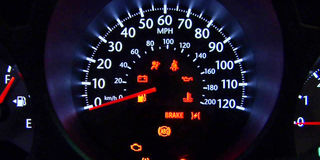Prime
Ask the Mechanic: Why is there an orange light on my dashboard?

Hello Paul, for about one week now, my car does not have any power and there is an orange warning light on the dashboard. What does it mean?
Angel
Hello Angel, your dashboard’s yellow or amber warning lights notify you of a component or system that needs service as soon as possible. Although that situation allows you to limp, it should be in the direction of your garage where it can be rectified. The most common amber or orange lights include the check engine or SRS warning lights, among others. The most commonly displayed amber/ orange dashboard light is the check engine light, which many motorists describe as the light that looks like a tiny helicopter.
The check engine light warns you that the engine needs to be inspected to identify a component that is affecting the emission system, increasing fuel consumption as well as reducing performance.
When that light shows, the engine computer has logged a fault code, which will let you know the faulty component or system. A computer diagnostic reading helps to access the engine’s computer-logged fault to enable speedy repair and avoid costly guesswork.
Common culprits include bad ignition coils, damaged oxygen sensors, or low (lean) fuel pressure, which a computer diagnostic check will accurately pinpoint.
Red lights on the other hand mean serious component or system failure, which warrants immediate stopping to address concerns such as low oil level/pressure, brake failure, battery charging failure or engine overheating.

WHAT CAUSES A CAR TO LEAN OR DIP FORWARD EXCESSIVELY?
Hello Paul, my car leans when turning and dips when braking. What could be causing it?
Simon
Hello Simon, it is unsettling as well as dangerous to drive when your car leans while turning and dips whenever you brake. The common cause of this is a failure of the suspension. Damaged or weaker coil springs and shock absorbers can cause vehicle extreme leaning when you turn through corners or dipping when you brake. Springs and shock absorbers help to maintain the stability of your car as you drive over imperfect sections of the road, manoeuvre around sharp corners or brake suddenly.
These components help absorb the different road forces and keep the vehicle stable and safe. When the springs or shock absorbers age, wear out or break, the vehicle tends to lose stability as it leans or dips excessively without quick recovery from road forces. They should be inspected and replaced where necessary.
Another cause of excessive leaning sideways can be a failure of the anti-roll bar, sway bar or stabiliser bar as it is commonly known. This bar is designed to help hold together the vehicle wheels and suspension to prevent rolling during extreme or sharp cornering. When these bars are worn out or damaged, the car tends to excessively lean sideways or experience a rolling sensation, which can lead to an accident. If your car has a damaged stabiliser or anti-roll bar, replace it with a new one immediately.
WHY IS THIS CVT GEARBOX NOT WORKING?
Hello Paul, my sister-in-law has an Outlander with engine model 4B12 and 4WD, I believe it is model 2007 which had issues with the gearbox (CVT) and the mechanic recommended a replacement of the gearbox. A used gearbox was secured from a dealer and fitted with the correct CVT fluids. Unfortunately, now, when you engage D, the car starts well but it will not shift gears. However, when you try driving it manually, it moves well. The mechanic says the car computer is faulty and we should order a new one. Is this an accurate diagnosis?
HB
Hello HB, whereas it may be possible that the CVT gearbox computer is faulty, it is also possible that there may be other faulty components responsible for its failure. There could be faulty wiring circuits or connectors between the gearbox and its computer, it might be necessary to carry out gearbox computer adaptation or software programming or the used CVT gearbox procured may have electrical or mechanical defects. Electrical wiring or circuits can sometimes be damaged by rodents or stress.
Connectors are sometimes damaged by corrosion. When this happens, the gearbox will not get vital signals from its computer to operate the electronic or hydromechanical components of the gearbox. The gearbox computer might need to be reprogrammed or adapted to the different gearbox fitted. Adaptation allows the gearbox computer to communicate with the newer gearbox electrical components.
A remote possibility is the used CVT gearbox you procured may be faulty. Your mechanic may need to tick all the above boxes before you replace the gearbox computer. A second opinion does not hurt either.




